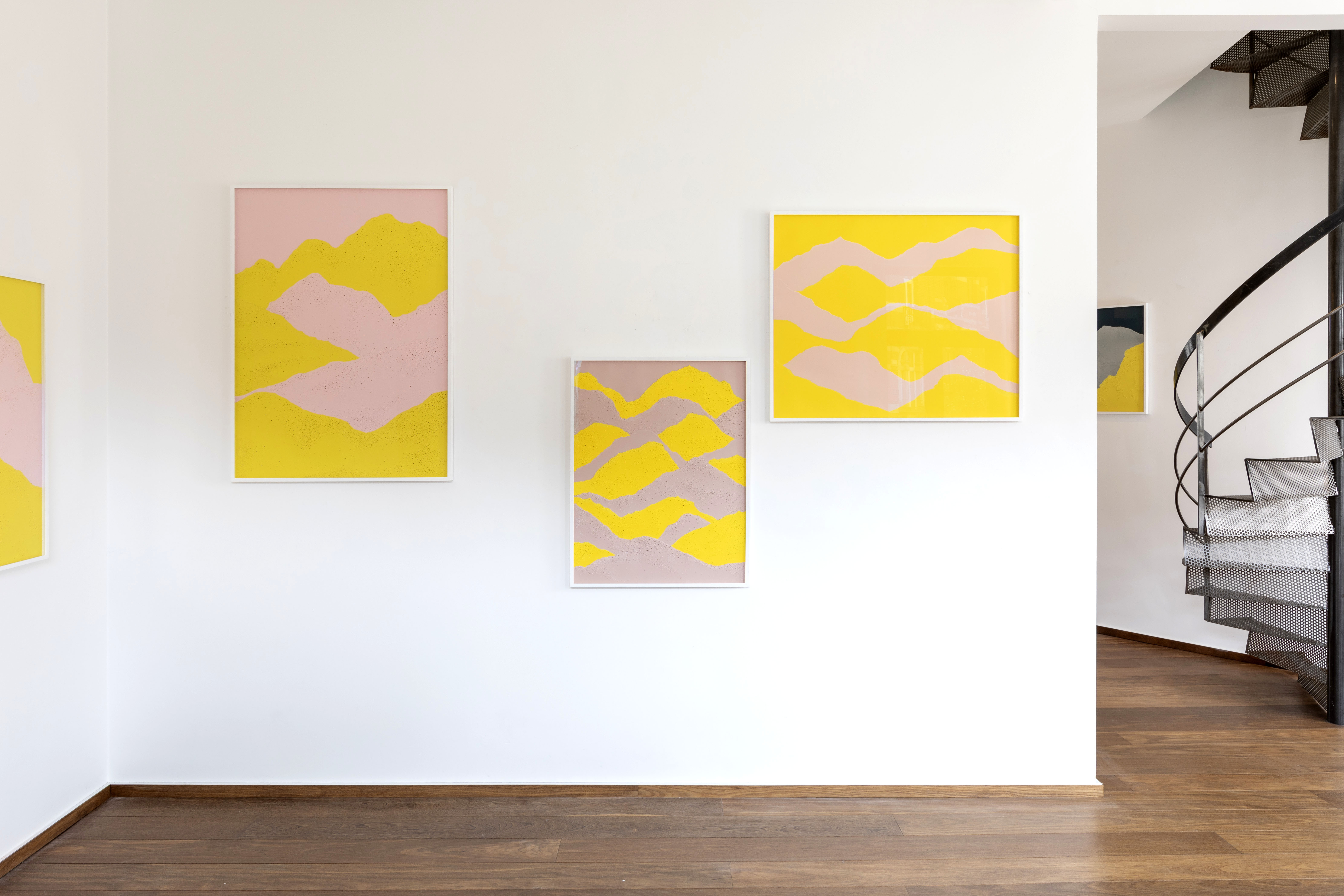Longueur d'ondes
Sophie Whettnall
April 17th - May 26th, 2018
Michel Rein, Brussels
Installation views



About
Joan Didion tells us that, as a teenager, Georgia O’Keefe painted “watercolors of cloudy skies because sunlight was too hard to paint.” I was reminded of this sentence when I first visited Sophie Whettnall’s studio on a sunny morning about a year ago. One of the windows was covered with two large wooden sheets, dark and perforated, so that the sunlight filtered into the studio not as an undifferentiated luminosity, but as shafts of light that fell in irregularly spaced dots on the studio floor, like glitter. It was hard to know what to look at—in other words, it was hard to know what was the work: the dots of light on the floor, or the sheets of paper covering the window.
Had the wooden sheets been placed on a wall instead, they would have produced a different effect and been an entirely different work. We could say that this ambiguity or indeterminacy is just another instance of a well-known trope of postmodern thought: the dissolution of the artwork into a pure an ephemeral affectivity. While there is no doubt truth to that, it may be the case that the ambiguity here is rooted in the paradoxical attempt of inventing ways to turn light itself, that most immaterial matter, into work.
Sophie Whettnall’s show, Longueur d’ondes, gives visitors the chance to see how deep this commitment to work with light runs in her work, and how varied and playful its manifestations can be. Probably the first thing to catch our eye as we enter the gallery is the in-situ intervention Black Dust, for which Whettnall uses black pigment to create a shadow effect. Black dots and blotches, sharp here and hazy there, spread across the gallery’s floor and walls, like the shadows of tree. Black Dust is the negative image of the work I saw at the artist’s studio: rather than capturing and forming light, this in-situ intervention evokes light through its opposite—shadows, darkness. Something similar is at play in the two other works that round out this show: Cotton Candy Landscapes and Plaster Landscapes.
Cotton Candy Landscapes, situated upstairs,is a new series of six drawingsdone using cutouts of pink and yellow paper. We see what the title invites us to imagine as mountain ranges or valleys, though these have been reduced to color swathes that eliminate everything that makes any landscape distinctive, giving us only ragged outlines in which the alternation between bright pink and soft yellow recreate the gradations of light. Looking at these works is a bit like looking at a landscape in the dying light of day, when everything in front of us starts to lose its specificity and to be visible only as more or less darkened shapes receding towards the barely illumined horizon. Or like the images in a geography textbook, where a landscape or terrain is rendered as a series of lines on a graph. But more than that distant memory from the classroom, Whettnall’s Cotton Candy Landscapes conjure up the—far more thrilling—memory of the fair, where most of us experienced for the first time the strange alchemy of sugar, of the color you pleased, being spun into candy on a wooden stick. Come to think of it now, cotton candy may be our first metaphysical moment, the first moment when sensory perception seems inadequate to the experience, to the conjuring of something out of nothing, the massive but weightless bulk, the liquefaction of matter in our mouth.
Plaster Landscapes is likewise a series of drawings done using nothing other than paper, but the similarities end there. Placed on the ground floor, in direct dialogue with Black Dust, the two Plaster Landscapes are a muted white that contrasts starkly with the colorful and naïve palette of the Cotton Candy Landscapes. They are larger and unframed; the paper, roughly cut and layered, like the scales of a fish or the ripples of a wind-swept sea, reach all the way across. While the Cotton Candy Landscapes give us a plane, the Plaster Landscapes are textured, sculptural: the undulating layers of paper create depth, and give us our clearest link yet to the show’s title. The Plaster Landscapesalert us to the centrality of the gesture and its performativity in the show, and their sculptural surface is in fact another way to play with light by containing its opposite—shadows and darkness—in the space between the layers.
It is silly of course to reduce the work of an artist who works in a variety of media—video, sculpture, etc.—to one element or fascination. I chose to speak about light here only because Longueur d’ondes seemed to offer an intriguing twist to the way Sophie Whettnall plays with light, for the show, whatever else it is, is also a tribute to the idea that absence is sometimes a more acute form of presence.
Emiliano Battista

